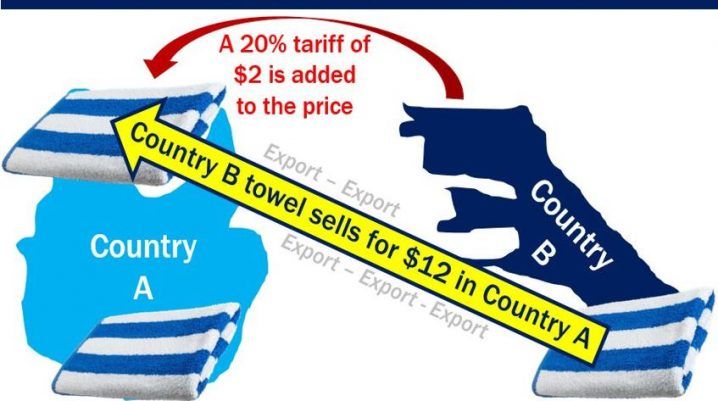Tariffs are a custom tax for imported and exported goods which assigned by the government. The tax is allotted based on the total cost of the goods. The tax is included for insurance and freight. It is mostly used in the United States. The tax is set according to the economic policy of the government.

Image courtesy: https://marketbusinessnews.com/financial-glossary/tariffs-definition-meaning/
The tariff is a tax for importing products from other countries. It will be placed on exports and imports among the two countries. It affects demand, supply, consumers, producers, and the world market. Tariff gives lots of clear outcomes for importers. It offers more advantages to domestic goods in the same market. There are various kinds of tariffs like ad valorem tariff, specific tariff, import license, and voluntary export restraint. However, it is used to increase the revenue of foreign policy. It helps customers to purchase goods on their budget. They use the tax to protect their industries from cheaper imports.
Advantages and disadvantages of tariff:
A tariff is offered based on foreign policy. Here you can explore the pros and cons of tariff
Maximize government revenue:
Tariffs offer certain sources of government revenues. Increased revenue gives a clear advantage to place import tax on foreign products.
Promote American goods:
When the US government choose to allot tax for imported product, them the manufacture decrease price of the good to compensate the tax. It makes customers buy the imported product at a limited cost. It let consumers operate less expense. It is beneficial for workers and the economy of the country.
Decrease customer choice:
The tariff offers great benefits for individual customers on international trade. It maximizes cost and minimizes trade prohibit customers. It increases the cost of many products in the US. It offers opportunities for customers to buy goods at a lower cost.
Discourage trade:
Businesses, individuals, and the government will avoid paying it. When the American customer shops low price products, then foreign suppliers get a disadvantage. It reduces trade in the US. The reduction of the trade make producer gets fewer amounts for their product.
Example of US tariffs:
You can see how tariffs custom tax functions in the following example. President Trump announced a tax percentage of import products as a 10% tariff on aluminum and a 25% tariff on steel. Trump did it to increase manufacturing works, but tariff will increase the cost of steel users. This tax includes additional traffic, and an enacted tariff. The additional tariff threatened by trump to import products with national security. It offers lots of benefits for importers and exporters in the US.
Conclusion:
Tariffs are paid by consumers of the products. The price of products is increased when it brought to any other country. It protects local industries and decreases the volume of the business. There are no trade restrictions on the trade agreement. So, explore complete information on tariff before trading.
